IGL Links Central High Students to the More Knotty Aspects of Mathematics
November 12, 2018
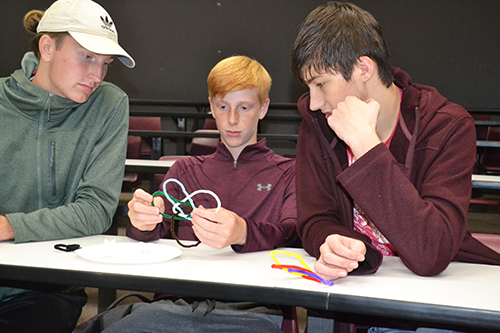
Central High students with knot that they created together.
Everyone is familiar with knots. There are simple knots, such as those we master when we’re five-year-olds learning to tie our shoelaces. Then there are some not-quite-as-simple knots, such as those sailors use when tying rope. But on Thursday, November 1st, a team of Illinois Geometry Lab (IGL) students visited Central High School’s AMSO club (Appplied Math and Science Outreach) to introduce the students to knot theory, with its even more complex mathematical knots and links, including Brunnian links. This unique learning opportunity was made possible thanks to the founder and President of the club, Anna Kinderman, who began the club in order to challenge her classmates in STEM, and who reached out to the IGL folks and organized the event.
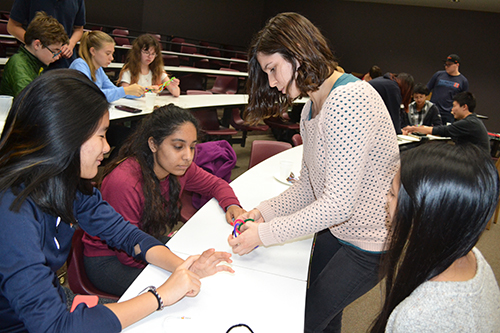
Alexi Block Gorman (standing) looks at the knot that Central High students made.
Knot theory is the study of mathematical knots. These differ from regular knots in that the ends are joined together so that they can’t be undone. For example, the simplest mathematical knot would be a ring. Brunnian links, according to Wikipedia, are named after Hermann Brunn, a German mathematician known for his work in knot theory. A Brunnian link becomes a set of unlinked circles if any one component is removed. In other words, cutting any loop frees all the other loops (so that no two loops can be directly linked.) Introducing these concepts to the high schoolers was the goal of the activity.
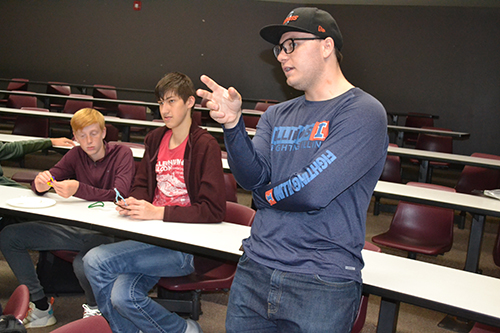
Central High students with knot that they created together.
Third-year Math PhD student Alexi Block Gorman, who researches Model Theory mentored by IGL Director, Assistant Professor Philipp Hieronymi, began the activity by explaining the basics of knot theory. Then she and her team of math undergrads used colorful pipe-cleaners as physical models to demonstrate the various knots. The AMSO students were then encouraged to study the properties of several interesting Brunnian links by trying to create them themselves.
Block Gorman, the IGL Outreach Coordinator in charge of planning & training for visits and events, says she actually chooses what activities IGL students will do with the different groups, maps out how the activity will run, then trains the undergraduate volunteers on conducting the activity.
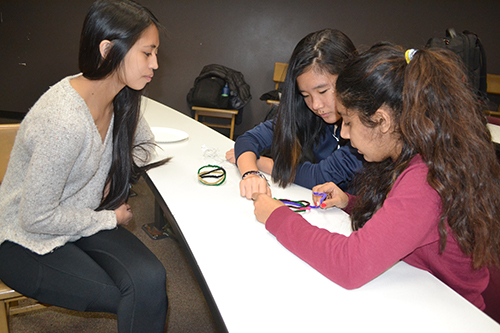
An IGL student (left) observes as Central High students work on their knot.
While the high schoolers benefitted from the activity, according to Block Gorman, the activity was a win-win; she and the IGL undergrads benefitted from it as well. For instance, the outreach activity gave them the opportunity to improve their math communication skills.
“People learn to communicate abstract ideas best by making themselves formulate the concepts in very simple terms,” Block Gorman explains. “By engaging high school students in higher-level math, they [IGL undergrads] get a chance to convey their excitement about math and also practice essential communication skills.”
How’d the IGL outreach go? Block Gorman reports that not only were the club members fun to work with, but the undergrads did really well too. “Our undergraduates are super enthusiastic about math and involving young people in mathematics early,” she says, “and they did a great job connecting with the high school students.”
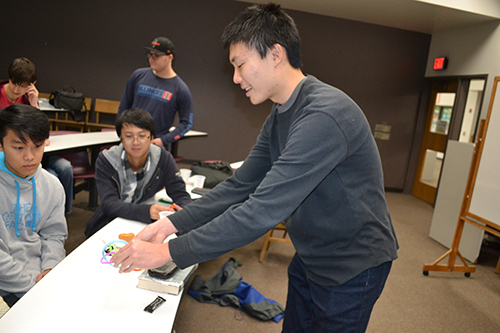
An IGL student (right) explains the knot theory to Central High student.
While Block Gorman claims that, as a grad student, she gains the same benefits that the undergrads do in terms of communicating science to a non-scientist audience. Plus, for her personally, it’s a way to give back. “I also remember being a child and having some really deep realizations about math when I was guided by really extraordinary teachers,” she acknowledges. “And I want to pay it forward. It's really rewarding when you can open up young minds to a new way of thinking and get to watch them discover concepts and skills for themselves.”
Another IGL staff member who is key to scheduling outreaches such as this one is third-year mathematics grad student Brian Shin, another Outreach Coordinator who serves as the liaison between IGL and the schools/clubs they visit. He shares why he’s excited about doing outreach activities with IGL.
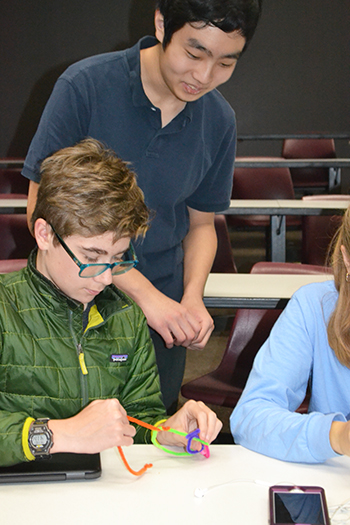
An IGL student (standing) looks upon as Central High students work on creating their knot.
“I feel that mathematics can be a wonderful and beautiful thing to anyone willing to take the time to explore it. Outreach is a way for me to share the experience and hopefully inspire some people to explore the beauty on their own.”
Shin hoped the outreach might expose students to aspects of math that they might not encounter at school, in hopes that the students they interacted with might learn about some interesting ideas and continue to explore them.
Shin’s math concentration is called homotopy theory, which roughly speaking studies the algebraic properties of geometric shapes, especially as “we deform/wiggle them,” he explains.
“Mathematics is a vast subject,” adds Shin. “In particular, there are a lot of really cool ideas to be had beyond the mathematics curriculum. We hope to show the students sides of math that they might not know exist.”
Serving as co-sponsors for the club are Central High teachers, Thomas Gelsthorpe and Elizabeth Dickinson. Gelsthorpe calls the students involved with the club “a very motivated and interested group of high school students.”
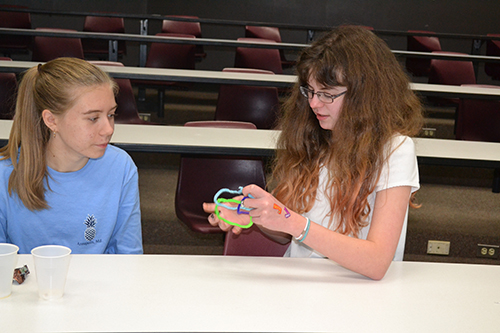
Central High students work on creating their knot.
The math and science outreach club usually meet most Thursdays, where they have someone come and present. For instance, for one meeting coming up, a man who wrote a cook book from the point of molecular gastronomy is going to present.
Regarding the folks that come and present, Gelsthorpe says they look for people or groups who are interested in interacting with a high school audience and meeting them at their level. The idea is that they say, "Hey, here's some really cool things that are going on!” while presenting them in a way that is “accessible, but also kind of leaves an opening for further learning,” he explains.
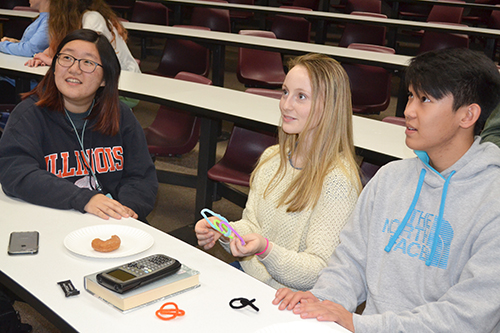
AMSO president and founder Anna Kinderman (center) and fellow members listen as they work on their knot.
Anna Kinderman, the president and founder of the club and a Central High junior, says her goal regarding AMSO is to make it easy for the participating students to learn. “I've put a lot of work into trying to organize these things,” she admits. She says her goal for the club is to ensure that “It's relatively easy to show up and learn a bunch of things on science, math—anything in between—in terms of careers, their interests.”
Plus, she’s learned a very important principle at her young age—one sure way to get people of all ages to attend functions: “They can come in and have free food!” she acknowledges.
While Kinderman had the opportunity to go to Uni High, she admits, “I really wanted to change something here in the public school system,” and explains that the idea of creating this club helped her make the decision to “stay here in the public school system and put something together like this.”
Story and photographs by Elizabeth Innes, Communications Specialist, I-STEM Education Initiative.
More: 8-12 Outreach, Central High School, Illinois Geometry Lab, Math, 2018
For more articles about Illinois Geometry Lab, please see:













.jpg)
















